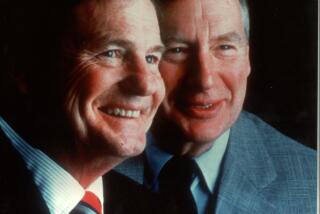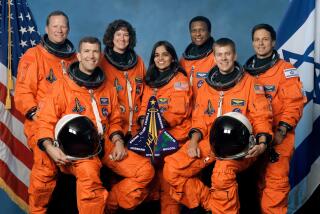HO-HUM THINKING SHIFTS TO ORGANIZED BEDLAM
It may be the ultimate paradox of this age that the technology that assaults us is the technology that comforts us. When Challenger exploded Tuesday, Americans turned to their electronic hearth, first to confront unthinkable horror and then to seek an understanding of it. Calendar’s Jay Sharbutt and David Crook talked to many who covered the tragedy. They didn’t have many more answers, but they did have pictures, words and, perhaps above all else, presence--eloquence for an age of images.
Suddenly the NASA announcer paused. There was an agonizing silence. Then, Cable News Network anchorman Tom Mintier, watching the television monitor in his Atlanta studio with growing horror, told viewers of the live telecast of the Challenger launch:
“We are awaiting word. They are holding their breath, as I’m sure everyone else is. You just saw, moments ago . . . a fireball fall from the sky.”
Minutes later, ABC, NBC and CBS--they hadn’t been airing the launch live, save on the West Coast broadcast of NBC’s “Today”--dropped their regular programming. They began covering the tragedy, running time and again the regular-speed and slow-motion videotaped replays of the fiery blast that killed the Challenger’s seven-member crew, including schoolteacher Sharon Christa McAuliffe.
Until Tuesday, space shuttle launches--24 since 1981--had become so routine that only CNN, whose sole business is news, had continued to televise each one live. The other networks usually went live with a launch only if it occurred during their morning news programs.
For several years now, they had simply monitored the launches and taped them for the evening news. For these launches, in addition to their launch-site news crews, each network kept a correspondent on stand-by in a studio in case an emergency developed.
Steve Bell, the news anchor for ABC’s “Good Morning America,” had that duty on the day the routine became the tragedy of a fiery explosion 18 miles off the coast of Florida.
“As I said on the air, we had all come to take these launches for granted, and this was a grim, jarring reminder of how we had ceased to appreciate exactly what was involved,” he said in a brief phone interview.
At 11:38 a.m. Tuesday, when Challenger was launched after a two-hour delay, Bell was sitting in ABC News’ Washington studio, watching a TV monitor. Like Mintier, he saw what seemed a blast 74 seconds after the shuttle soared upward.
At first, he didn’t believe his eyes. But a split second later, he said, “There was the visual evidence . . . you just knew what had to have happened, and I began yelling to get on the air.” He got on the air at 11:43 a.m. EST.
The scene was repeated in New York at CBS News, where producer Lane Venardos hollered at anchorman Dan Rather to get in the “flash booth” set aside for news bulletins, and at NBC News, where “Today” news anchor John Palmer was on stand-by.
(Although the West Coast broadcast of “Today” is aired on a tape-delay basis, NBC cut away from it for a live report of the launch and the ensuing explosion, that coverage by KNBC-TV newsman Kent Shocknek in Los Angeles.)
Shortly after going on the air, Bell and Palmer were succeeded by their networks’ evening news anchormen, Peter Jennings and Tom Brokaw, respectively. Those two had dashed over from a White House briefing for correspondents on President Reagan’s planned State of the Union speech, which was postponed shortly after the Challenger exploded.
Behind the scenes, all the networks’ special events units hastily began collecting and airing file tape on the history of shuttle flights and the Challenger crew, particularly McAuliffe. Correspondents did live reports from the Kennedy Space Center and from McAuliffe’s home town of Concord, N.H.
Interviews were arranged hastily with politicians, scientists and former and present astronauts.
It was organized bedlam, and like his network counterparts, CNN Vice President Robert Furnad was heavily involved. He first got word of the Challenger accident while attending a meeting across town at what will be CNN’s new offices in Atlanta.
“I was called to the phone and told the shuttle had exploded,” he said. His initial reaction? “I guess my first thought was, ‘Well, it was going to happen sometime . . . so now where do we go from here?’ ”
The possibility of trouble had been on his mind earlier that day, he said, because “both this shuttle and the previous one had had problems . . . because of this we probably were paying more attention to this launch.”
The day was not without callousness--perhaps unwitting--by some viewers. An ABC News spokeswoman said that 80% of about 1,200 viewers who called the network’s New York’s office about the Challenger coverage criticized ABC for preempting its soap operas.
Officials at CBS and NBC said only a handful of such complaints were received by their New York offices.
At CNN, a 24-hour news operation that says it serves 33.5 million homes in the United States, anchorman Mintier understandably was tired when interviewed by phone late Tuesday.
He had started work at 6 a.m., been on the air 9 1/2 hours straight, and was due to return to work at 2 a.m. Wednesday.
He called the Challenger tragedy “a nightmare that I’ve gone through dozens of times” in his mind before each space shuttle launch.
“Usually, the night before a launch, I have the same recurring nightmare, the worst-case scenario of what can happen,” he said. “It’s kind of eerie that people have said to me, ‘They’re (the launches) so ho-hum.’ ”
He never has felt that way, he said, and in fact had taken a much closer interest in the shuttle program after meeting astronaut Michael J. Smith, a guest commentator for CNN during its coverage of a launch last year.
Smith was one of the seven Challenger crew members killed on Tuesday.
“He’d invited me to this launch,” Mintier said. “It was his first flight. He knew I couldn’t come to the launch because I was busy here, but still, he took the time to send me an invitation anyway.
“Every time one (shuttle) goes up, I hold my breath. I was holding it when I saw this one explode. I just jumped up and looked at the monitor, hoping to see the shuttle come through that ball of fire. But it never came out. It never came out.
“My first thought went to the families of the crew . . . and then, how to describe the undescribable.”
More to Read
The biggest entertainment stories
Get our big stories about Hollywood, film, television, music, arts, culture and more right in your inbox as soon as they publish.
You may occasionally receive promotional content from the Los Angeles Times.










